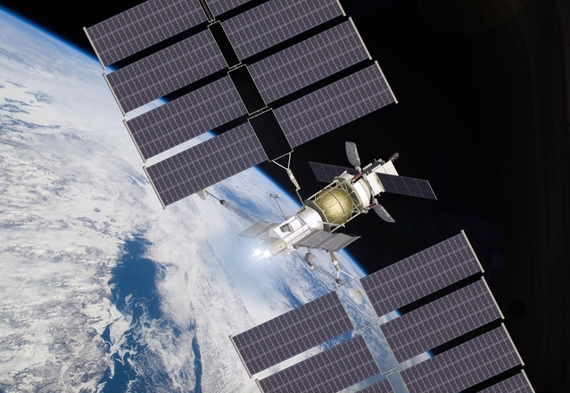
The dawn of the space age occurred on October 4, 1957, when the then Soviet Union launched Sputnik 1. This very small satellite was in orbit for three months before burning up in the Earth's atmosphere, as is the eventual fate of all of the other 3000 satellites orbiting the Earth right now. So why is this important? Other than worrying about them possibly falling on your head; how does this affect your daily life? Well, if you shop or make your bank transactions online, use your GPS to find where you are going, check the weather on your cell phone, then you are using these satellites. When you travel, you hope your airline pilot and the captain of your vacation cruise liner have their onboard navigation info up and running. Or perhaps you just like to watch satellite TV. We are all dependent on these satellites to carry out an increasing number of our routine daily activities.
Spinoffs from space exploration technology are far ranging and affect our daily lives with many products and services which originated from these needs. Advancements in medical diagnostics include advancement in the enhanced image processing used in MRI and CT scans, LED technologies that can be used in treating tumors and infrared technologies such as those that are used with ear thermometers or your cool touch night light. Materials science has given us memory foam, firefighter gear and fire retardant paints, insulation and coatings. Freeze dry technology has expanded the ability to store food with higher nutritional content and longer shelf life. Nutrition research for astronauts has helped to fortify baby food with essential fatty acids, not previously included and necessary for the development of the nervous system. Anti-icing aircraft systems, highway safety and improved radial tire technology also stemmed from space inspired technology development. Current global space business related activities are a 300 billion dollar industry.
Ad Astra Rocket Company -- a cutting edge spaceflight engineering company headquartered three miles to the West of the NASA Johnson Space Center, and about 25 miles south of the city of Houston -- aims to play a big part in further advances in space technology for exploration, as well as develop solutions for earth applications. Ad Astra is celebrating its ninth year of operation, advancing the development of plasma propulsion technology with its unique VASIMR engine (short for Variable Specific Impulse Magnetoplasma Rocket). Ad Astra was incorporated on January 14, 2005, when NASA's Advanced Space Propulsion Laboratory (ASPL) where the VASIMR was initially developed, was privatized through a Space Act Agreement between Ad Astra and NASA. The company has been perfecting the technology since. VASIMR is an electric thruster that uses noble gases like argon, krypton or xenon as propellants. The gas is heated to extreme temperatures by radio waves to form plasma (an electrically charged gas). The superheated plasma flows in a magnetic duct and escapes at great velocity through a magnetic nozzle to produce thrust.
The invention of the VASIMR engine began with development in 1979, while I was working at The Charles Stark Draper Laboratory in Cambridge Massachusetts. I continued this work at the MIT Plasma Fusion Center before moving the project to the Johnson Space Center in 1994. The company's name -- Ad Astra, Latin for "to the stars" -- is representative of the vision and passion for space exploration propelling our research team forward on this quest. All the others are just way points, but we don't want to get too far ahead of ourselves. Space exploration has been my dream since his childhood; it continues to be a long-term goal of my company's rocket technology development team.
But, in addition to pursuing space exploration as a continuation of the human drive to explore, the Ad Astra team has its commercial sights closer to home where the VASIMR engine can be used to propel space "trucks" that could clean up the orbital debris rapidly accumulating in the high traffic lanes where our satellites must travel. It can also be used to gently push on the International Space Station and other space stations to come in the future, in order to keep their orbits stable. Our company is also developing uses of the VASIMR engine in asteroid capture, retrieval and deflection missions as part of its business plan.
This post was produced by The Explorers Club and The Huffington Post in conjunction with the Club's Annual Dinner on Saturday, March 15, at the Waldorf Astoria in New York City, to honor pioneers in exploration and technology. The authors in this series are all members of The Explorers Club. For more information about the Club, please visit the website, which will feature a live stream of the event the evening of the Dinner. To read all posts in the series, click here.